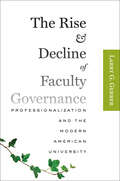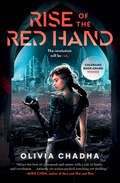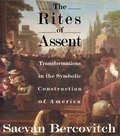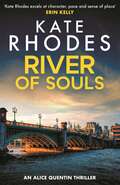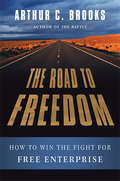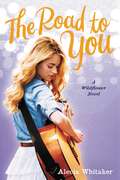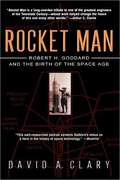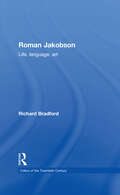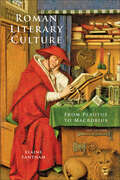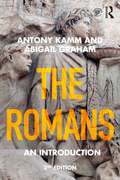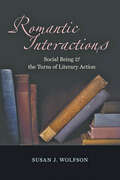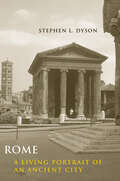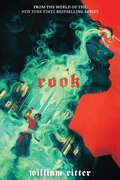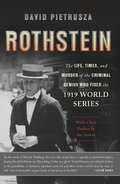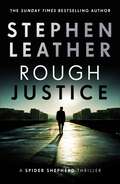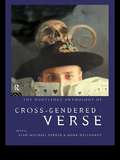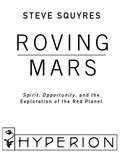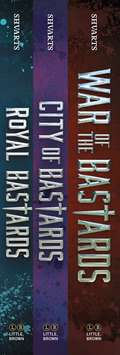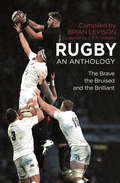- Table View
- List View
The Rise and Decline of Faculty Governance: Professionalization and the Modern American University
by Larry G. GerberThe Rise and Decline of Faculty Governance is the first history of shared governance in American higher education. Drawing on archival materials and extensive published sources, Larry G. Gerber shows how the professionalization of college teachers coincided with the rise of the modern university in the late nineteenth century and was the principal justification for granting teachers power in making educational decisions. In the twentieth century, the efforts of these governing faculties were directly responsible for molding American higher education into the finest academic system in the world. In recent decades, however, the growing complexity of "multiversities" and the application of business strategies to manage these institutions threatened the concept of faculty governance. Faculty shifted from being autonomous professionals to being "employees." The casualization of the academic labor market, Gerber argues, threatens to erode the quality of universities. As more faculty become contingent employees, rather than tenured career professionals enjoying both job security and intellectual autonomy, universities become factories in the knowledge economy. In addition to tracing the evolution of faculty decision making, this historical narrative provides readers with an important perspective on contemporary debates about the best way to manage America’s colleges and universities. Gerber also reflects on whether American colleges and universities will be able to retain their position of global preeminence in an increasingly market-driven environment, given that the system of governance that helped make their success possible has been fundamentally altered.
The Rise and Decline of Faculty Governance: Professionalization and the Modern American University
by Larry G. GerberThe Rise and Decline of Faculty Governance is the first history of shared governance in American higher education. Drawing on archival materials and extensive published sources, Larry G. Gerber shows how the professionalization of college teachers coincided with the rise of the modern university in the late nineteenth century and was the principal justification for granting teachers power in making educational decisions. In the twentieth century, the efforts of these governing faculties were directly responsible for molding American higher education into the finest academic system in the world. In recent decades, however, the growing complexity of "multiversities" and the application of business strategies to manage these institutions threatened the concept of faculty governance. Faculty shifted from being autonomous professionals to being "employees." The casualization of the academic labor market, Gerber argues, threatens to erode the quality of universities. As more faculty become contingent employees, rather than tenured career professionals enjoying both job security and intellectual autonomy, universities become factories in the knowledge economy. In addition to tracing the evolution of faculty decision making, this historical narrative provides readers with an important perspective on contemporary debates about the best way to manage America’s colleges and universities. Gerber also reflects on whether American colleges and universities will be able to retain their position of global preeminence in an increasingly market-driven environment, given that the system of governance that helped make their success possible has been fundamentally altered.
The Rise and Fall of Mass Marketing (Routledge Library Editions: Marketing)
by Richard S. Tedlow Geoffrey JonesThis book provides new insights into the changes in interpretation of marketing and the evolution of marketing strategies during the twentieth century. The focus is on the development of mass marketing in the United States and the way in which more flexible and adaptable forms of marketing have increasingly been taking over. This highly international volume draws contributors from the USA, Europe and Japan, and from a variety of academic disciplines, including marketing, economics and business history. Chapters provide detailed analysis of the marketing of a range of products including cars, washing machines, food retailing, Scotch whisky, computers, financial services and wheat.
The Rise of the Chinese Economy: The Middle Kingdom Emerges
by Greg MastelIn this analysis of the roots and objectives of Chinese economic and industrial policy, Mastel outlines the implications of China's rise for the world economy. He then proposes strategies to address the hazards this rise will pose as well as the opportunities it will create.
Rise of the Red Hand (The\mechanists Ser. #1)
by Olivia ChadhaA rare, searing portrayal of the future of climate change in South Asia. A streetrat turned revolutionary and the disillusioned hacker son of a politician try to take down a ruthlessly technocratic government that sacrifices its poorest citizens to build its utopia.
The Rise to Power of the Chinese Communist Party: Documents and Analysis
by Tony Saich Benjamin YangThis collection of documents covers the rise to power of the Chinese communist movement. They show how the Chinese Communist Party interpreted the revolution, how it devised policies to meet changing circumstances and how these policies were communicated to party members and public.
Risk Management for Enterprises and Individuals
by Etti Baranoff Patrick Lee Brockett Yehuda KahaneThis book is intended for the Risk Management and Insurance course where Risk Management is emphasized. When we think of large risks, we often think in terms of natural hazards such as hurricanes, earthquakes or tornados. Perhaps man-made disasters come to mind such as the terrorist attacks in the U.S. on September 11, 2001. Typically we have overlooked financial crises, such as the credit crisis of 2008. However, these types of man-made disasters have the potential to devastate the global marketplace. Losses in multiple trillions of dollars and in much human suffering and insecurity are already being totaled, and the global financial markets are collapsing as never before seen. We can attribute the 2008 collapse to financially risky behavior of a magnitude never before experienced. The 2008 U.S. credit markets were a financial house of cards. A basic lack of risk management (and regulators' inattention or inability to control these overt failures) lay at the heart of the global credit crisis. This crisis started with lack of improperly underwritten mortgages and excessive debt. Companies depend on loans and lines of credit to conduct their routine business. If such credit lines dry up, production slows down and brings the global economy to the brink of deep recession or even depression. The snowballing effect of this failure to manage the risk associated with providing mortgage loans to unqualified home buyers have been profound, indeed. When the mortgages failed because of greater risk- taking on the Street, the entire house of cards collapsed. Probably no other risk-related event has had, and will continue to have, as profound an impact world wide as this risk management failure. How was risk in this situation so badly managed? What could firms and individuals have done to protect themselves? How can government measure such risks (beforehand) to regulate and control them? These and other questions come to mind when we contemplate the consequences of this risk management fiasco. Standard risk management practice would have identified sub-prime mortgages and their bundling into mortgage-backed-securities as high risk. People would have avoided these investments or would have put enough money into reserve to be able to withstand defaults. This did not happen. Accordingly, this book may represent one of the most critical topics of study that the student of the 21st century could ever undertake. Risk management will be a major focal point of business and societal decision making in the 21st century. A separate focused field of study, it draws on core knowledge bases from law, engineering, finance, economics, medicine, psychology, accounting, mathematics, statistics and other fields to create a holistic decision-making framework that is sustainable and value- enhancing. This is the subject of this book.
The Rites of Assent: Transformations in the Symbolic Construction of America
by Sacvan BercovitchThe Rites of Assent examines the cultural strategies through which "America" served as a vehicle simultaneously for diversity and cohesion, fusion and fragmentation. Taking an ethnographic, cross-cultural approach, The Rites of Assent traces the meanings and purposes of "America" back to the colonial typology of mission, and specifically (in chapters on Puritan rhetoric, Cotton Mather, Jonathan Edwards, and the movement from Revival to Revolution) to the legacy of early New England.
River of Souls: Alice Quentin 4 (Alice Quentin)
by Kate RhodesJude Shelley, the daughter of a prominent cabinet minister, was assaulted and left for dead in the river Thames. Her attacker was never caught. A year later, forensic psychologist Alice Quentin is asked to re-examine the case.Then another body is found: an elderly priest, washed up at Westminster Pier. An ancient glass bead is tied to his wrist. Alice is certain that the Shelleys are hiding something - and that there will be more victims unless she can persuade them to share what they know. The Thames has always been a site of violent sacrifice. And Alice is about to learn that some people still believe in its power...
The Road to Freedom: How to Win the Fight for Free Enterprise
by Arthur C. BrooksEntrepreneurship, personal responsibility, and upward mobility: These traditions are at the heart of the free enterprise system, and have long been central to America&’s exceptional culture. In recent years, however, policymakers have dramatically weakened these traditions—by exploding the size of government, propping up their corporate cronies, and trying to reorient our system from rewarding merit to redistributing wealth. In The Road to Freedom, American Enterprise Institute President Arthur C. Brooks shows that this trend cannot be reversed through materialistic appeals about the economic efficiency of capitalism. Rather, free enterprise requires a moral defense rooted in the ideals of earned success, equality of opportunity, charity, and basic fairness. Brooks builds this defense and demonstrates how it is central to understanding the major policy issues facing America today.The future of the free enterprise system has become a central issue in our national debate, and Brooks offers a practical manual for defending it over the coming years. Both a moral manifesto and a prescription for concrete policy changes, The Road to Freedom will help Americans in all walks of life translate the philosophy of free enterprise into action, to restore both our nation&’s greatness and our own well-being in the process.
The Road to You (Wildflower #2)
by Alecia WhitakerBright lights...screaming fans...cute roadies...country music sensation Bird Barrett has officially arrived.Next up on the road to stardom, Bird's heading out on tour. Between opening for one of the biggest acts in country music and meeting a passionate young photographer who's working as part of the backstage crew, the weeks pass by in an exciting blur. It might even be enough to distract Bird from the way things ended--or never quite started--with Adam Dean.When the tour wraps, though, it's back to reality. The label is eager for a new hit song, but the sudden fame, complete with a media-fueled rivalry with another country music starlet, has Bird questioning her priorities. Before she can pour her heart into her music, she'll need to figure out where it truly lies. Filled with sweet country music spirit, Wildflower is a series you just can't get out of your head.
Rocket Man: Robert H. Goddard and the Birth of the Space Age
by David A. ClaryMore famous in his day than Einstein or Edison, the troubled, solitary genius Robert H. Goddard (1882-1945) was the American father of rocketry and space flight, launching the world's first liquid-fuel rockets and the first powered vehicles to break the sound barrier. Supported by Charles Lindbergh and Harry Guggenheim, through fiery, often explosive, experiments at Roswell, New Mexico, he invented the methods that carried men to the moon. Today, no rocket or jet plane can fly without using his inventions. Yet he is the "forgotten man" of the space age. His own government ignored his rocketry until the Germans demonstrated its principles in the V-2 missiles of World War II. The American government usurped his 214 patents, while suppressing his contributions in the name of national security, until it was forced to pay one million dollars for patent infringement. Goddard became famous again, monuments and medals raining upon his memory. But his renewed fame soon faded, and Goddard's pivotal role in launching the Space Age has been largely forgotten.
Roman Jakobson: Life, Language and Art (Critics of the Twentieth Century)
by Richard BradfordIn Roman Jakobson Richard Bradford reasserts the value of Jakobson's work, arguing that he has a great deal to offer contemporary critical theory and providing a critical appraisal the sweep of Jakobson's career. Bradford re-establishes Jakobson's work as vital to our understanding of the relationship between language and poetry. By exploring Jakobson's thesis that poetry is the primary object language, Roman Jakobson: Life, Language, Art offers a new reading of his work which includes the most radical elements of modernism. This book will be invaluable to students of Jakobson and to anyone interested in the development of critical theory, linguistics and stylistics.
Roman Literary Culture: From Plautus to Macrobius (Ancient Society and History)
by Elaine FanthamScholars of ancient literature have often focused on the works and lives of major authors rather than on such questions as how these works were produced and who read them. In Roman Literary Culture, Elaine Fantham fills that void by examining the changing social and historical context of literary production in ancient Rome and its empire. Fantham’s first edition discussed the habits of Roman readers and developments in their means of access to literature, from booksellers and copyists to pirated publications and libraries. She examines the issues of patronage and the utility of literature and shows how the constraints of the physical object itself—the ancient "book"—influenced the practice of both reading and writing. She also explores the ways in which ancient criticism and critical attitudes reflected cultural assumptions of the time.In this second edition, Fantham expands the scope of her study. In the new first chapter, she examines the beginning of Roman literature—more than a century before the critical studies of Cicero and Varro. She discusses broader entertainment culture, which consisted of live performances of comedy and tragedy as well as oral presentations of the epic. A new final chapter looks at Pagan and Christian literature from the third to fifth centuries, showing how this period in Roman literature reflected its foundations in the literary culture of the late republic and Augustan age. This edition also includes a new preface and an updated bibliography.
The Romans: An Introduction
by Antony Kamm Abigail GrahamThe Romans: An Introduction, 3rd edition engages students in the study of ancient Rome by exploring specific historical events and examining the evidence. This focus enables students not only to learn history and culture but also to understand how we recreate this picture of Roman life. The thematic threads of individuals and events (political, social, legal, military conflicts) are considered and reconsidered in each chapter, providing continuity and illustrating how political, social, and legal norms change over time. This new edition contains extensive updated and revised material designed to evoke the themes and debates which resonate in both the ancient and modern worlds: class struggles, imperialism, constitutional power (checks & balances), the role of the family, slavery, urbanisation, and religious tolerance. Robust case studies with modern parallels push students to interpret and analyze historical events and serve as jumping off points for multifaceted discussion. New features include:? Increased emphasis on developing skills in interpretation and analysis which can be used across all disciplines. Expanded historical coverage of Republican history and the Legacy of Rome. An expanded introduction to the ancient source materials, as well as a more focused and analytical approach to the evidence, which are designed to engage the reader further in his/her interaction and interpretation of the material. A dedicated focus on specific events in history that are revisited throughout the book that fosters a richer, more in-depth understanding of key events. New maps and a greater variety of illustrations have been added, as well as updated reading lists. A further appendix on Roman nomenclature and brief descriptions of Roman authors has also been provided. The book’s successful website has been updated with additional resources and images, including on-site videos from ancient sites and case studies which provide closer "tutorial" style treatment of specific topics and types of evidence. Those with an interest in classical language and literature, ancient history, Roman art, political and economic systems, or the concept of civilization as a whole, will gain a greater understanding of both the Romans and the model of a civilization that has shaped so many cultures.
Romantic Interactions: Social Being and the Turns of Literary Action
by Susan J. WolfsonIn Romantic Interactions, Susan J. Wolfson examines how interaction with other authors—whether on the bookshelf, in the embodied company of someone else writing, or in relation to literary celebrity—shaped the work of some of the best-known (and less well-known) writers in the English language. Working across the arc of Long Romanticism, from the 1780s to the 1840s, this lively study involves writing by women and men, in poetry and prose. Combining careful readings with sophisticated literary, historical, and cultural criticism, Wolfson reveals how various writers came to define themselves as "author." The story unfolds not only in deft textual analyses but also by provocatively placing writers in dialogue with what they were reading, with one another, and with the community of readers (and writers) their writings helped bring into being: Mary Wollstonecraft and Charlotte Smith in the Revolution-roiled 1790s; William Wordsworth and Dorothy Wordsworth in the society of the Lake District; Lord Byron, a magnet for writers everywhere, inspired, troubled, but always arrested by what he (and his scandal-ridden celebrity) represented. This fresh, informative account of key writers, important texts, and complex cultural currents promises keen interest for students and scholars, literary critics, and cultural historians.
Rome: A Living Portrait of an Ancient City (Ancient Society and History)
by Stephen L. DysonStephen L. Dyson has spent a lifetime studying and teaching the history of ancient Rome. That unparalleled knowledge is reflected in his magisterial overview of the Eternal City.Rather than look only at the physical development of the city—its buildings, monuments, and urban spaces—Dyson also explores its social, economic, and cultural histories. This unique approach situates Rome against a background of comparative urban history and theory, allowing Dyson to examine the dynamic society that once thrived there. In his personal effort to reconstruct the city, Dyson populates its streets with the hurried politicians, hawking vendors, and animated students that once lived, worked, and studied there, bringing the ancient city to life for a new generation of students and tourists. Dyson follows Rome as it developed between the third century BC and the fourth century AD, dividing the great megalopolis into distinct neighborhoods and locales. He shows how these communities, each with its own unique customs and colorful inhabitants, eventually grew into the great imperial capital of the Italian Empire. Dyson integrates the full range of sources available—literary, artistic, epigraphic, and archaeological—to create a comprehensive history of the monumental city. In doing so, he offers a dramatic picture of a complex and changing urban center that, despite its flaws, flourished for centuries.
Rook
by William RitterThis standalone adventure set in the world of the New York Times bestselling Jackaby series brims with humor, heart, and—of course—a hefty dose of supernatural mayhem. Abigail Rook never intended to be the mortal bridge between the human and supernatural world. But now, the power of the Sight--and all the chaos that comes with seeing the essential truth of everything, every human, fairy, werewolf, enchanted slip of paper, and municipal building, at all times--is hers alone. With this overwhelming new gift, she should be able to solve crimes and help New Fiddleham, New England find calm in its supernatural chaos. The only problem? She has no idea what she&’s doing. And New Fiddleham isn't waiting for Abigail to be ready. Local witches and other magical beings are going missing, as tensions between human and supernatural residents curdle into a hatred that could tear the city apart. Abigail's fiance, Charlie, works alongside her to unravel the magical disappearances, but as a shapeshifter, he's under threat as well. Then Abigail's parents appear, ready to take her back to England and marry her off to someone she's never met. Abigail has no choice but to follow her Sight, her instincts, and any clues she can find to track a culprit who is trying destroy everything she holds dear.
Rothstein: The Life, Times, and Murder of the Criminal Genius Who Fixed the 1919 World Series
by David PietruszaHistory remembers Arnold Rothstein as the man who fixed the 1919 World Series, an underworld genius. The real-life model for The Great Gatsby's Meyer Wolfsheim and Nathan Detroit from Guys and Dolls, Rothstein was much more-and less-than a fixer of baseball games. He was everything that made 1920s Manhattan roar. Featuring Jazz Age Broadway with its thugs, speakeasies, showgirls, political movers and shakers, and stars of the Golden Age of Sports, this is a biography of the man who dominated an age. Arnold Rothstein was a loan shark, pool shark, bookmaker, thief, fence of stolen property, political fixer, Wall Street swindler, labor racketeer, rumrunner, and mastermind of the modern drug trade. Among his monikers were "The Big Bankroll," "The Brain," and "The Man Uptown." This vivid account of Rothstein's life is also the story of con artists, crooked cops, politicians, gang lords, newsmen, speakeasy owners, gamblers and the like. Finally unraveling the mystery of Rothstein's November 1928 murder in a Times Square hotel room, David Pietrusza has cemented The Big Bankroll's place among the most influential and fascinating legendary American criminals. 16 pages of black-and-white photographs are featured.
Rough Justice: The 7th Spider Shepherd Thriller (The Spider Shepherd Thrillers)
by Stephen LeatherThe seventh book in the bestselling Dan 'Spider' Shepherd series. Villains across London are being beaten, crippled and killed by vigilante cops. Crime rates are falling, but the powers that be want Dan 'Spider' Shepherd to bring the wave of rough justice to an end. Shepherd has always known that there are grey areas in the fight against crime. And that sometimes justice gets lost in the process.He has never been comfortable investigating cops, but working for the Serious Organised Crime Agency means that he has no choice. He has to go undercover with an elite group of officers who are at the sharp end of policing, risking their lives daily on the toughest streets in the Capital.But Shepherd has hard decisions of his own to make when his family is in the firing line.
The Routledge Anthology of Cross-Gendered Verse
by Alan Parker Mark WillhardtBoth male and female poets cross the gender line: men assume a female voice and women a male voice. The Routledge Anthology of Cross-Gendered Verse is a fascinating collection of such poems, beginning in the age of Chaucer and working its way through to the present day. Together these poems offer a unique collection of masks, personae and voices, rife with issues of class, gender and race. Alan Parker and Mark Willhardt, in bringing together these poems for the first time, assert an entirely new paradigm; a theoretical and practical reading of a heretofore undefined genre. They also provide a critical introduction which synthesizes traditional literary debates with current gender theory and, through the lens of historical, literary, social and theoretical issues, present a new way to interpret these 'ventriloquized' poems. The Routledge Anthology of Cross-Gendered Verse provides a wealth of material for students and teachers of literature and gender studies. It is a compelling collection which will also appeal to poetry lovers.
The Routledge Guidebook to Descartes' Meditations (The Routledge Guides to the Great Books)
by Gary HatfieldDescartes is widely regarded to be the father of modern philosophy and his Meditations is among the most important philosophical texts ever written. The Routledge Guidebook to Descartes’ Meditations introduces the major themes in Descartes’ great book and acts as a companion for reading this key work, examining: The context of Descartes’ work and the background to his writing Each separate part of the text in relation to its goals, meanings and impact The reception the book received when first seen by the world The relevance of Descartes’ work to modern philosophy, it’s legacy and influence With further reading included throughout, this text follows Descartes’ original work closely, making it essential reading for all students of philosophy, and all those wishing to get to grips with this classic work.
Roving Mars: Spirit, Opportunity, and the Exploration of the Red Planet
by Steven SquyresSteve Squyres is the face and voice of NASA's Mars Exploration Rover mission. Squyres dreamed up the mission in 1987, saw it through from conception in 1995 to a successful landing in 2004, and serves as the principal scientist of its $400 million payload. He has gained a rare inside look at what it took for rovers Spirit and Opportunity to land on the red planet in January 2004--and knows firsthand their findings.
Royal Bastards Series Collection (Royal Bastards)
by Andrew ShvartsJoin an epic, action-packed magical adventure, full of conspiracies and danger, in the Royal Bastards fantasy series.Royal Bastards: Being a bastard blows. Tilla would know. Her father, Lord Kent of the Western Province, loved her as a child, but cast her aside as soon as he had trueborn children. At sixteen, Tilla spends her days exploring long-forgotten tunnels beneath the castle with her stablehand half-brother, Jax, and her nights drinking with the servants, passing out on Jax's floor while her castle bedroom collects dust. Tilla longs to sit by her father's side, enjoying feasts with the rest of the family. Instead, she sits with the other bastards, like Miles of House Hampstedt, an awkward scholar who's been in love with Tilla since they were children. The bastards band together, realizing they alone have the power to prevent a civil war that will tear their kingdom apart—if they can warn the king in time....City of Bastards: Tilla is safe from her murderous father in the dazzling capital of Lightspire, where she lives a life of luxury under the protection of the Volaris King, alongside her boyfriend, Zell, and best friend, Princess Lyriana. So why isn't she happy? Maybe it's the whispers and stares that follow her wherever she goes, as the daughter of the traitor waging war against Lightspire. Or maybe it's the memories of her beloved brother, Jax, who lies cold in his grave even as she tries to settle into a life in the city's prestigious University. Then Tilla stumbles upon the body of a classmate—a friend. The authorities are quick to rule it a suicide and sweep it under the rug, but when Tilla herself is attacked by a mysterious man with terrifying powers, she's convinced of a conspiracy. Her friends beg her to stay silent; what she's suggesting is impossible...and treasonous. The deeper she digs, the more questions she uncovers....War of the Bastards: A year has passed since the fall of Lightspire. The Inquisitor Miles Hampstedt rules Noveris with a blood-soaked iron fist. Tilla and her friends have become hardened rebels in the Unbroken, a band of guerilla fighters hiding out on the fringes of the Kingdom protecting the true queen, Lyriana Volaris. Even as they fight, they know their cause is doomed—that with every passing day Miles's army of Bloodmages spreads across the continent. But at least they have each other...and some halfway-decent drinks. With Miles's forces closing in, a ragtag team sets out on an eleventh-hour mission: form an alliance with Syan's people that could turn the tide of the war. But what they discover in the Red Wastes changes everything, including their very understanding of the magic that runs through Noveris. In the heart-pounding conclusion to the Royal Bastards trilogy, Tilla faces an impossible choice: unthinkable destruction in the name of peace...or an uncertain future that means confronting a terrible past.
Rugby: The Brave, the Bruised and the Brilliant (Dis Wheeler & Ross Ser.)
by Brian LevisonInspiring and irreverent by turns, Brian Levison's new anthology has drawn on rugby's wealth of excellent writing. Frank Keating, P. G. Wodehouse, Alec Waugh, A. A. Thomson, John Reason and Mick Imlah are among the distinguished names who have written movingly, amusingly and entertainingly about the game they loved. Great players such as Brian O'Driscoll, Willie John McBride, J. P. R. Williams, Chester Williams, Colin Meads, Gavin Hastings and Brian Moore give us a fascinating insider's view, as does World Cup Final referee Derek Bevan, who reveals what it is like to try to control thirty powerful and often volatile men in a highly competitive situation. But some of the best writing and the wittiest insights come from those who played their rugby at a much less exalted level. The origins of the game - sometimes true, sometimes fanciful - are explored as are some of its rituals like the haka. There are amusing tales including that of the four Tibetan boys sent by the Dalai Lama to learn the game at Rugby School and an account of New Zealand scrum-half Chris Laidlaw's hostile reception at a village fête in Wales. Along with barely believable stories about the game's hardest men, including the French coach Jean 'le Sultan' Sébédio, who used to conduct training sessions wearing a sombrero and wielding a long whip, and 'Red' Conway who had his finger amputated rather than miss a game for South Africa. One section 'Double Vision' looks at the same incident from opposing viewpoints, such as when the then relatively inexperienced Irish immortal Willie John McBride took a swing at the mighty All Black Colin Meads in a line-out. Another, 'Giving it Everything', shows how exceptional courage was not restricted to the rugby field but extended to the battle grounds of the First World War. From the compiler of highly acclaimed All in a Day's Cricket, this selection covers the game from virtually every angle and is sure to delight any rugby fan.
